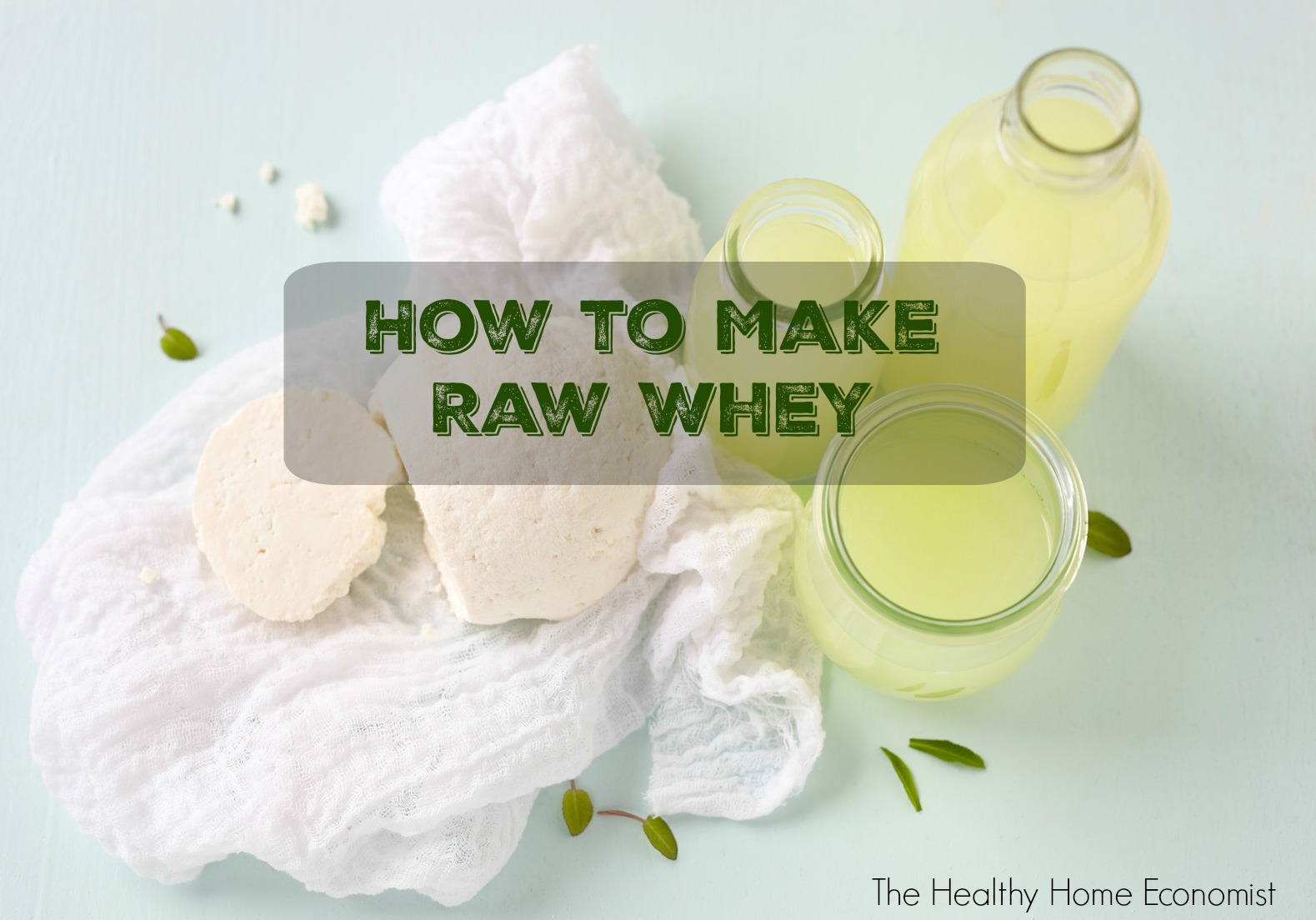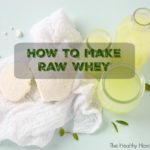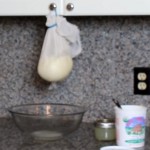How to make raw, enzyme and probiotic-rich liquid whey to use as a starter culture for all your home fermentation needs.

Do you know how to make whey from yogurt, kefir or raw milk?
A by-product of this simple technique is healthy homemade cream cheese that is loaded with enzymes and probiotics.
The recipe below describes how with visual instructions via video demonstration!
Making homemade baby formula? I recommend using this “quick whey” no straining method as the fastest and easiest approach.
How to Make Whey the REAL Way
Making real, liquid, nutrient rich, unadulterated whey in your own kitchen is a MUST step for any traditional cook to learn.
Without whey in its whole, liquid form, many other traditional recipes cannot even be attempted. You cannot buy whey from the store except in a denatured, unhealthy, powdered whey form. It is worth your time to learn what I show you in the video below.
Other video lessons on this blog show you how to use this whole food form of whey to make many delicious, healthful recipes for your family. Whey as made in the video demo below will keep up to 6 months in the refrigerator in a sealed mason jar.
If you absolutely have no access to farm fresh milk to make whole, unadulterated, enzyme rich whey, then you can use plain, organic yogurt brand from the store instead. Here are tips on how to spot the best yogurt brands.
The process is basically exactly the same thing as shown in the video.
You won’t get nearly as much whey using yogurt as clabbered, farm fresh milk, but at least you can get enough to get you started.
Wonderful Whey and REAL Cream Cheese
The raw, enzyme-rich cream cheese I make in the recipe video below is fantastic on a sprouted or sourdough bagel for breakfast. Don’t buy the Ezekiel sprouted muffins as they contain soy. This low-carb bagel recipe is another great one to try.
If you prefer to buy, these sourdough bagels are available for shipping freshly made to your door.
To make, just take your cream cheese left over from making liquid whey and add a few strawberries and a dash of dark maple syrup to taste. Mix together by pulsing a few times in your food processor. This wonderful, fresh, REAL strawberry cream cheese will last one to two weeks in the refrigerator. Another wonderful use for this healthy raw cheese is to make an easy no bake cheesecake.
No access to raw milk where you live? No problem. Check out this recipe plus video on how to separate whey from yogurt purchased from the store.
Cloudy Whey vs Clear Whey
No matter whether your whey turns out cloudy or clear, it is safe and fine to use in all your favorite recipes. This article explains why sometimes whey is cloudy compared to its usual golden color.

Raw Whey Recipe
How to separate raw, liquid whey from clabbered milk. The process also creates probiotic rich cream cheese.
Ingredients
- 1 quart raw milk preferably grassfed
- 1 large glass bowl
- 1 large rubber band
- 1 white dishtowel
Instructions
-
Allow the raw milk to sit on the counter for 1-3 days at room temperature.
-
When the milk separates into curds and whey (transforms into clabbered milk) you are ready to proceed. Note that the fresher the raw milk and the colder the temperature of your house, the longer it will take the raw milk to clabber.
-
Line a clean, large glass bowl with a clean, white dishtowel that isn’t too thick. Cheesecloth will also work, but the holes in the mesh must be very small, else the milk curds will pass through.
-
Gently pour the clabbered milk into the middle of the dish towel. Gather up the ends and fasten with a rubber band. Attach to a knob on an upper cabinet in your kitchen as shown in the picture.

-
Let the raw whey drip into the bowl underneath. This process will continue for an hour or two.
-
After the dripping stops, gently take down the hanging bag and place it into a clean bowl. Scrape out the raw cream cheese that is inside the bag, put in a container with a lid and refrigerate.
-
Pour the liquid whey from the dripping bowl into a glass mason jar, afix the lid and refrigerate.
-
Refrigerated, raw cream cheese will be good to eat for about a week. Raw whey will last several months refrigerated.
Recipe Video
How to Use Whey in Recipes
How to Make Ricotta Three Ways (plus Video How-to)
Perfect Probiotic Cottage Cheese
Cheese Making: Common Problems and Solutions








Hi, Sarah:
Is the difference between making cream cheese and making cottage cheese the length of time that you allow the milk to clabber? Will allowing it to clabber longer have any effect on your whey?
Thanks,
Candace
Thank you! You made it look so simple. I tried it this weekend and now we have a lovely stawberry cream cheese to spread on our homemade soaked muffins tomorrow morning. I really appreciate your blog – thanks for all you do 🙂
Hi Kim, that is a great question that I really am not sure the answer to. Nourishing Traditions cookbook says that the milk to make whey and cream cheese should be nonhomogenized and raw goat milk is naturally homogenized, as you know. If you give it a try, please comment again and let us know if it works!
OOPS! I didn’t know goat milk (raw) was naturally homogenized…I make all my cheese, whey, kefir from goat milk and it’s delish! 🙂
I know that I’m responding to a very old post but…
I suspect that calling goats milk “naturally homogenized is probably not accurate. While the milk fats are small enough to remain suspended, I suspect (but do not know) that these fats are probably “contained” is the same manner as for cows milk.
As I understand it, the real problem with cows milk is that when homogenized the fats rapidly become rancid because the fats are no longer protected.
Hi Sarah, Enjoy your blog so much and just have a quick question – can you make whey from raw goat's milk – a couple of us have an allergy to cow's milk. Thanks so much for any help.
Hi Kim, I realize it’s been a long time since this post, but In case anyone is wondering, yes you can make it from goat milk. I do it all the time. Ricotta, mozerella, cream cheese, etc. It’s ALL good! I will say that my children and I are the only ones who love the goat’s milk products. My husband doesn’t appreciate it when I use goat ricotta to make his lasagna. 🙂
To add to what Liz posted, yes… I make it from goat milk yogurt, actually. I make the yogurt myself (using organic, but pasteurized, goat’s milk and a non-dairy starter culture, and fermenting for 24 hours), then hang and drip. The nice thing with this method is that you can make a batch of yogurt, whey and cream cheese (well, technically yogurt cheese, tastes the same) at the same time.
Sarah THANKS!!
I did this once before and I was not sure if my whey came out correctly… seeing the color of yours showed me that I did do it correctly. How can you tell if it has been in the fridge too long? I made about a half of a gallon and I still have a quart…and I think I am going on 6 months.
I like the idea on how you hung it… I made a mess. My cloth was too small and I tried doing it with a pitcher. What a mess.
The cream cheese seemed to firm up more when I refrigerated it too.
Thanks again.
r
Hi Audry, yes it does spread very well on a bagel. The stuff from the store is artificially thickened – the real stuff is more like a pudding in my experience.
I could have left the cream cheese in the cloth to drip out the whey further which would have made the cream cheese firmer as you mentioned. I did not make it with skim milk .. it was whole milk. No, cream cheese is not made with just cream. Have you read Nourishing Traditions cookbook? Cream cheese and yogurt cheese are made in the way that I show in the video.
Hi Sarah, you are great! Thank you for sharing. Would it be safe to consume the whey if I left the old raw milk rest for 2 days in an open container (plastic cup) The curd is floating in the whey. It’s shaped as a cylinder and is firm. It looks like mozzarella but the only thing I did was to let the raw milk to rest. The whey smells good. I think I can scoop the cylinder (cheese) out of the whey with no problem. Should I eat it? Oh my, This would be my first time eating something like this, so I’m just making sure.
Hi Sarah, even gentle pasteurisation will kill the probiotics in fhe fresh milk? Asking, because free range goats could be infected from ticks or so, drinking raw milk isn’t an option here. I like to drink the byproduct from farmers cheese, but now, I am not sure, do I give myself the benefits of my own home pasteurised milk? Thanks
Yes, even low temp pasteurization kills all the probiotics. This would mean any temperature above 118F.
Does the cream cheese stiffen up at all if you put it in the fridge? I have some sour milk in the fridge right that I'm now planning to make whey and cream cheese from as soon as I get home… but what you have there doesn't really look like it's thick/ stiff enough to spread on a bagel.
Thanks for this video! My milk is on the counter clabbering as I type this. 🙂
Doesn't cream cheese need to be made with just the cream? I've never made it with the skimmed milk before. The skimmed milk has a gelatinous texture that I'm not fond of so I use that for semi-hard cheeses. The cheese you made in your video did not look like traditional cream cheese (I'm not talking store-bought, but just cream cheese). Cream cheese is thick and holds it's own shape. I'm not quite sure what you just made.
If you go to gnowlings.com she uses cream to make her cream cheese instead of sour milk. It is just as firm as normal store bought cream cheese from the pictures. She follows the same method as Sarah did with the towel and whey. She does let her cream cheese sit for 18-24 hours too. She also has a friend who uses buttermilk instead of cream. I would prefer the sour milk personally because it saves me from buying cream on a normal basis.
As a side note: The lady from gnowlings makes her sour cream with sour milk. She lets her milk sit in a glass mason Jar with a paper towel and rubber band covering the top. She skims off the cream two-three days later and she has what looks like really good sour cream.
Just a thought I would share this with you. Thanks for the great video Sarah, will be sure to make sure of my sour milk this coming week.
I think you mean http://www.gnowfglins.com